Wondering how to crate train an older dog? If so, help is here! Integrative veterinarian Dr. Julie Buzby explains why crate training is so important, even for older dogs, and provides easy to follow steps for teaching your senior dog to accept being in the crate. Plus, she answers five common FAQs about crate training.
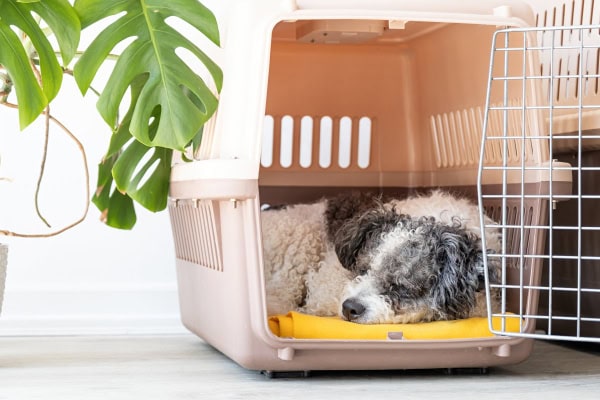
“You can’t teach an old dog new tricks.”
As a veterinarian and a pet parent, I am happy to say that this cliché does not apply to senior dogs! It is absolutely possible to teach an old dog new tricks.
Training senior dogs can be both beneficial and fun. And some skills are especially important to learn—such as crate training.
Why is crate training important for older dogs?
Learning to be comfortable in the crate is valuable for senior dogs, adult dogs, and puppies. Even if you never intend to use a crate, there are situations where a crate may be necessary. For example:
- At the veterinary hospital—Your dog may need to be in a cage if he or she is staying at the clinic for surgery, testing, monitoring, or hospitalization.
- Emergency evacuation situations (fires, flooding, hurricanes, etc.)—Sometimes people need to evacuate to a safety zone or designated evacuation shelter. Usually, these evacuation shelters require pets to be in crates.
- After surgery or an injury—Certain injuries or surgeries require crate rest during the healing period. In some cases, your dog may need to be on crate rest for several weeks. It will be much easier for you and your dog to get through this period if your dog is already crate trained.
These scenarios are often already stressful for dogs—especially senior dogs who might not hear or see as well and who may be easily confused. But dogs who are familiar with crates and who are trained to be comfortable in them are more likely to be relaxed.
What are some benefits of crate training?
Even if you don’t think it is a skill that your dog will use, there are many benefits of crate training an older dog (or any dog).
Providing a place where they feel safe
Many dogs who are crate trained enjoy their crate. It feels like a safe, secure place for them to be.
For example, my dogs all love their crates. They will voluntarily go into them during the day if they are tired or want to get away from the commotion of my kids or company. Also, my dogs prefer to eat in their crates where they each have their own safe space.
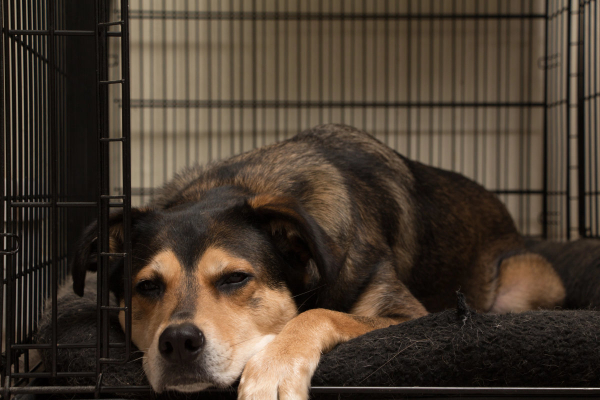
Reducing anxiety
Along the same lines, crate training can reduce your dog’s anxiety around certain situations.
With separation anxiety, dogs sometimes need a place to feel secure and safe. The crate can provide this for them. Additionally, some dogs’ separation anxiety is triggered by staring at the front door or listening to sounds outside. Being in a crate that is away from the door and/or in a room with white noise or other distractions can help reduce the impact of those triggers.
Additionally, crates are beneficial for dogs who develop anxiety due to canine cognitive dysfunction (CCD)—also known as doggy dementia. Dogs with CCD can feel disoriented and unsure of their surroundings, especially if you are traveling or visiting a new location. Crates are consistent (even if you take them to a new place) and hold your dog’s smell. They can provide a familiar and comforting spot for your disoriented dog to lie down and feel grounded.
Keeping your dog safe from harm
Dogs with CCD may wander the house at night because they are confused and experiencing sundowners in dogs. And dogs who are blind can struggle to navigate the house, especially at first. In both situations, it is possible that your dog could walk into objects or fall down stairs and become injured. Having a crate (or another safe place) for your dog to be at night or when unsupervised is a wonderful way to reduce the risk of injury.
Finally, some dogs are prone to eating things they shouldn’t. Putting them in the crate when you can’t keep an eye on them can greatly reduce the chances they will eat a toxic substance or get a GI obstruction from swallowing a foreign object.
How to crate train an older dog: 8 steps
All of these benefits make it well worth crate training your older dog. As you work on figuring out the best method for crate training, the biggest thing to remember is to keep things positive. If the training sessions are fun and relaxed, your dog is more likely to build positive associations with the crate and feel comfortable using it.
Let’s take a look at how you can successfully crate train a senior dog (or dog of any age).
Step 1: Develop positive thoughts about the crate
This first step might seem silly, but it is more important than you might think. Before you can begin crate training your dog, it helps to ensure you are going into the experience with a positive attitude.
If you are holding on to negative associations with crates or training, it is likely that your dog will sense these feelings and become nervous. To reframe your thoughts, it can help to remember that with proper crate training, most dogs tolerate (and even enjoy) being in a crate. And crate training, like learning other skills or tricks, can be a fun activity for you and your dog to work on together.
Step 2: Select the crate that is best for your dog
The next step is to select a crate. When you go shopping for crates, you will see that there are many assorted sizes and types available. It’s not possible to cover all the different options in this article. But I will highlight the pros and cons of a few types of crates:
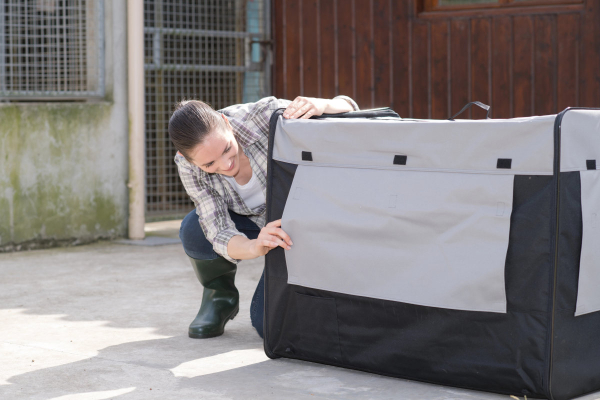
Soft fabric crates
This crate style is appealing to dog parents because it is compact, easy to store and move, and often appears “comfier”. Fabric crates can be great for dogs who are calmer and more relaxed. Plus, the soft fabric may be better for dogs with arthritis than lying on a hard crate floor.
However, soft crates are usually not the best choice for dogs who are anxious or who have a habit of chewing or eating things they shouldn’t (especially fabric). These crates are not as durable as other options and are easier for the dog to escape from.
Plastic crates
There are so many types of plastic crates. I love these crates for most dogs because they are usually quite sturdy. They also tend to be more enclosed. This can be beneficial for dogs who are disoriented (like with CCD). Plastic crates are also a wise choice for dogs who seem to feel more secure in an enclosed area. (The dogs who seem to like blanket “caves” or want to hide behind objects when they are scared.)
However, it is possible for a motivated dog with destructive habits to chew on or “eat” a plastic crate.
Wire crates
Wire crates (depending on the strength of the wire) are often the most durable and strongest crates. They are also the easiest to clean, in my opinion, if you have a dog who struggles with housetraining due to puppyhood, diabetes in dogs, urinary incontinence, or other conditions.
Wire crates are wonderful for dogs who want to have a safe place to retreat, but who still like to see what is going on around them and feel like they are in a more open space.
Between plastic and wire crates, some dogs do fine with either option. But other dogs seem to have a preference for one specific style. If you feel like your dog is not doing well with one type, perhaps it’s worth trying another.
Crate sizing
In addition to the type of crate, it is also important to select the proper size for your dog. Many dog parents are aware that crates can be too small for a dog, making the dog feel cramped and uncomfortable.
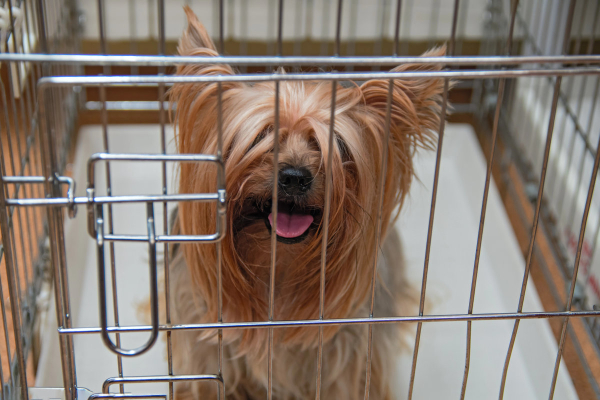
But it is also important to note that some dogs may be less comfortable in a crate that is too big. An oversized crate may not feel as much like a cozy den. And it also gives the dog room to go potty at one end and hang out at the other, which isn’t good for housebreaking.
When choosing the size for your dog’s crate, your dog should be able to:
- Stand inside without hitting his or her head on the ceiling
- Lie down in the crate and stretch the legs out without hitting the sides
- Complete a circle to lie down
If he or she can’t do those things, the crate is too small.
Step 3: Expose your dog to the crate
Once you have selected a crate, the next step is to make sure your dog is comfortable with the crate. Don’t just stick your dog in it and see how she or he reacts. If your dog has never been in a crate before or has previous negative experiences with a crate (which can be especially true for some rescue dogs) this can cause your dog to be overly fearful of the crate.
Instead, when you bring the crate home, set it up in an area of the house where your dog feels comfortable. Leave the door open. Let the crate sit like this for a few days so your dog can walk by it and explore it at his or her own pace. This will allow your dog to sniff it and investigate the crate without the pressure of being put inside.
It is possible that your dog may wander into the crate on his or her own. If so, that is great! Don’t jump up to close the door and trap him or her inside. Instead, verbally praise your dog for going inside and provide pats or a treat as a reward.
When your dog no longer shies at the sight of the crate and can walk by it calmly or without acknowledging it, move on to the next step.
Step 4: Develop a positive relationship with the crate
For this step, you still are not putting your dog in the crate. Instead, you are going to do things that your dog enjoys near the crate. Possible ideas include:
- Sitting on the ground next to the crate while petting your dog
- Putting your dog’s favorite toy near the crate so he or she must walk by it to get the toy
- Playing with your dog and his or her favorite toy near the crate
- Feeding your dog next the crate
- Setting your dog’s favorite treat near the crate (You can start with the treat farther away if your dog is still nervous about the crate and progressively move the treat closer to the crate as your dog becomes more comfortable. You can even put the treat on the crate, so your dog must touch the crate to grab the treat off of it).
Step 5: Teach your dog to enter the crate
Once your dog has started to develop a positive relationship with the crate and has become increasingly comfortable around it, it’s time to move onto the next step—entering the crate. Remember that you will have more success if you don’t force your dog inside. Rather, use positive reinforcement to encourage your dog to go in on his or her own.
During this step, continue leaving the door of the crate open.
Choose a high value treat or toy
When teaching your dog to enter the crate, you need to entice your dog inside. The best way to do this is to use special treats or toys. During any type of training session (whether crate training or teaching commands), I encourage dog parents to use novel, high value rewards.
For example, if your dog is treat driven, having a special treat that is unique to training sessions is a wonderful way to motivate your dog. Or if your dog likes toys, using a toy that is just for training is a good idea.
Note: If you are using treats to train your dog, be aware of how many treats (and what kind of treats) you are giving your dog. Do not give too many—especially if they are high in calories or fat.
Use the treat or toy to entice your dog into the crate
Once you have chosen your dog’s motivator, start setting the reward just inside the crate opening. Let your dog step inside the crate to grab the treat or toy. As your dog becomes more comfortable, set the reward father back into the crate.
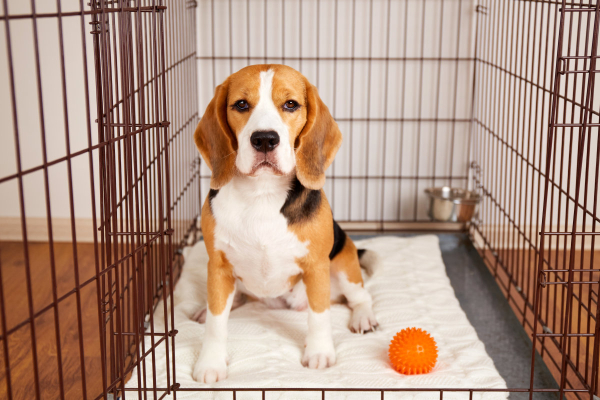
Gradually increase how far back the reward is placed until your dog is stepping into the crate completely. At every point, remember to verbally praise your dog and reward him or her for going inside the crate.
Be patient
Some dogs may be naturally brave and willing to go all the way into the crate. If that is the case with your dog, this step may not take very long.
However, other dogs are very hesitant and need lots of repetition to get comfortable. In that case, this step may take multiple sessions and days to achieve. If your dog remains hesitant, you may need to put treats at the front, middle, and back of the crate. This gives your dog motivation each step of the way.
In either case, it is important to give your dog the time he or she needs to feel confident going into the crate on his or her own. If you rush this step, it could cause your dog to become fearful.
Step 6: Increase the time your dog is in the crate with the door open
Once your dog is going in the crate on his or her own, try increasing the amount of time that your dog is spending in the crate. During this step, the door of the crate should still stay open.
The best way to encourage dogs to spend longer periods of time in the crate is by feeding them their meals inside the crate. You can also place your dog’s water inside the crate.
This will further cement the idea in your dog’s brain that the crate is a positive environment.
Step 7: Close the door of the crate for a brief time
Once your dog can successfully stay inside the crate for a few minutes or longer, it is time to try closing the door of the crate. It is best to gradually build up the amount of time your dog is inside the crate with the door shut.
At first, only close the door for a second
Start by closing the door for just a second before immediately opening it again. That way your dog can come out if he or she wishes. This shows your dog that you can be trusted to let him or her out.
Encourage your dog to step inside the crate again and then shut the door for another second. Repeat this step a few times to enforce the idea that your dog is not trapped. During this process, continue to reward your dog verbally. You can also offer treats while your dog is in the crate.
Then increase the time the door is closed
Once your dog remains calm when he or she sees you close the door, keep the door closed a few seconds longer. Gradually add a few seconds each time you shut the door. And continue to reward your dog with treats, toys, and/or verbal praise.
The key is to open the door before your dog appears restless or agitated. At this point, you are still reinforcing the idea that it’s safe to be in the crate with the door closed. You aren’t working on being in the crate for longer periods of time yet.
Step 8: Increase the time your dog spends in the crate
Now that your dog is comfortable spending short amounts of time in the crate with the door closed, you can start adding on more time.
Use your dog’s response to gauge how quickly to increase time in the crate
Again, be aware of the signals your dog is giving you. A calm dog may have a wagging tail, soft eyes, and relaxed muscles. Or he or she may also lie down in the crate and rest. If this is the case, it is okay to continue to increase how long your dog is in the crate.
But if your dog becomes agitated or nervous, let him or her out. Do something different as a distraction (such as going on a walk). Then try again later when your dog is happy and calm again.
Each time you get to the point where your dog can be in the crate and remain relaxed for a certain number of minutes, add on a few more minutes. Gradually work up to leaving your dog in the crate for longer periods of time (a few hours).
The first few times that your dog is in the crate for extended periods should be when you are home. That way, you can monitor your dog and reassure him or her that everything is okay. As your dog spends more time in the crate over multiple sessions, he or she should continue to become more comfortable.
Consider finding a way for your dog to stay entertained in the crate
As you increase the duration of crate time, your dog may remain relaxed but start to get bored. If your dog is happy but beginning to fidget or appear more energetic, he or she may need a distraction while in the crate.
This is where safe chew toys for dogs can come in. Or you could consider trying out some mental stimulation toys for dogs while your dog is in the crate. However, it is important to ensure that whatever toy you put in the crate is safe for your dog. Avoid anything that could break into small inedible pieces, have sharp ends, fracture teeth, pose a choking hazard, or create an intestinal obstruction.
Understand that it is a process
Please note that some ups and downs are expected during this training. Just like learning most new things, the process is not linear and often takes time and patience.
But eventually your dog will be relaxed in the crate. And he or she may even find the crate soothing and choose to spend extended periods of time in there on his or her own. At this point, you have successfully crate trained your dog!
FAQs about crate training an older dog
Hopefully, crate training goes smoothly for your dog. But if it doesn’t, the answers to some of these FAQs may help with the process.
Can I crate train an older dog with separation anxiety?
The short answer is yes, it is possible, and even potentially beneficial to crate train a dog who has separation anxiety or starts to show signs of separation anxiety once crated. However, it may be a bit more challenging.

If your dog appears to be experiencing separation anxiety, start by asking yourself a few questions:
- Does my dog already have separation anxiety that started before I ever tried crate training?
- If so, what measures have I used in the past to decrease the separation anxiety and how well are they working? Can I apply them to being in the crate too?
- Does my dog act like he or she is afraid of the crate?
- If so, has my dog seemed scared from the start? Did something happen in the crate that scared him or her?
- Does my dog seem fine with the door open but get nervous once I close the door?
- If so, is it immediately when I shut the door? Or is it not until I’m out of sight or after a certain period of time?
Tips for crate training dogs with separation anxiety
If it is a specific part of the crate training process that appears to cause anxiety in your dog, spend longer on that step. Use extra positive reinforcement to reward your dog and help him or her feel comfortable around the crate. Sometimes this means you might need to go back a few steps, and that’s ok!
Alternatively, if your dog has generalized anxiety or separation anxiety even when not crated, it is important to work with your vet to address and manage the anxiety first. Then, once you have a plan in place and your dog is less anxious, you can resume crate training.
Additionally, if your rescue dog previously had traumatic or negative associations with the crate, it may be worth seeking professional help (veterinarian, veterinary behaviorist, or vet-recommended dog trainer) sooner rather than later.
What if my dog is barking and whining in the crate?
Barking and whining in the crate is often associated with boredom or anxiety.
If your dog appears bored in the crate, using safe toys and enrichment activities like those I mentioned in step 8 can help reduce barking and whining. So can exercising your dog or playing some brain games before crating him or her. Wearing your dog out makes him or her more likely to just want to snooze—rather than bark or whine— while in the crate.
If your dog appears anxious, determining the cause of the anxiety and managing it can help. Sometimes you just need to go back a few steps or slow down the process of crate training. Other times, it may involve working with your vet to develop a more extensive anxiety-management plan.
My dog is having accidents in the crate. What should I do?
Dogs can have accidents in the crate for several reasons. If you are working on housebreaking a puppy or recently-adopted adult dog or senior dog, you may need to shorten the amount of time in the crate at first. Then, as your dog progresses with housetraining, he or she should hold it in the crate longer.
In the case of an older dog with urinary incontinence, you may need to let your dog out more frequently. You might also want to put down pee-pads in the crate to help absorb any accidents or talk to your vet about incontinence medications. While it doesn’t solve the accident issue, using a bigger crate so your dog can get away from an accident may be helpful for dogs with poorly-controlled incontinence.
Should I give my dog blankets, water, or toys in the crate?
What you put in the crate with your dog depends quite a bit on what your dog is like.
Blankets or bedding in the crate offer improved comfort but are not safe for chewers
Some dogs (especially senior dogs who are sore and painful due to osteoarthritis in dogs) may do better in the crate with soft beds and blankets. These items can certainly make a crate more comfortable for a dog and provide incentive to go inside.
However, for dogs who are chewing machines, blankets and beds could be dangerous. If a dog decides to chew on the bedding, the material could become lodged in the dog’s digestive tract. This can lead to GI upset and possibly even an intestinal blockage that requires surgery.
Toys in the crate provide entertainment but you need to ensure they are safe for your dog
Puzzle toys or chew toys can be a great distraction for dogs in crates. This is especially true for dogs who are crated for longer periods of time or will be on dog crate rest for multiple days or weeks.
However, it is extremely important to only give your dog items that are safe for your dog’s size and chewing style. Avoid toys that could break, become choking hazards, fracture teeth, or cause intestinal blockages. If you aren’t sure if a toy is safe for your dog, consult your veterinarian or don’t give it to your dog.
Dogs can have water in the crate but it could get messy or lead to more accidents
Regarding water, this is usually a safe option to leave in the crate if you wish. Just ensure the bowl is not one that a dog could chew on or ingest pieces of.
However, dogs who move in the crate a lot may spill the water and make a mess. Or if your dog is in the process of housebreaking or has incontinence, having water in the crate and not being able to go outside to go to the bathroom may increase the chance of potty accidents.
When do I need to ask for help with crate training?
If you have worked through the steps for crate training at an appropriate speed for your dog and followed the guidelines in the FAQs but your dog still appears anxious, agitated, or upset in the crate, it may be time to ask for help.
Your veterinarian is a great resource. He or she can help determine what might be causing your dog’s agitation in (and outside of) the crate. Then your vet will work with you to formulate a plan.
Just like people, some dogs are more anxious than others. These dogs may need the help of calming supplements or anti-anxiety medications like trazadone for dogs. Or nervous dogs may benefit from behavior modification, special exercises, or sessions with a veterinary behaviorist or vet-recommended dog trainer.
The bottom line is this: If your dog is struggling with crate training, don’t give up. There are resources and people who can help you.
Regularly reinforce your dog’s crate training
Once you and your older dog have mastered this new skill, it is worth putting in the work to keep your dog’s crate training fresh in his or her mind. This is easy enough if you plan to use the crate regularly for your senior dog.
But if you don’t routinely crate your dog, please continue to practice crate training occasionally. Just like other skills, it can be forgotten if it is not used. Occasionally pull the cage out and put some treats or toys inside of it for your dog. Then let your dog spend time in the crate relaxing and enjoying his or her special treat. This helps your dog remember that the crate is a safe and positive place.
Crate training your older dog is worth it
Crate training your older dog can require time, patience, and dedication. But it is worth it in the end! It is such an important skill for all dogs (puppies and seniors alike) and has many benefits.
Hopefully, the steps and tips in the article have given you the tools you need to crate train your senior dog. But if it isn’t going well, please don’t be afraid to reach out to your veterinarian. Sometimes having another person to help troubleshoot is all it takes to move you and your dog from stress to success.
Have you tried to crate train an older dog?
Please comment below.


We welcome your comments and questions about senior dog care.
However, if you need medical advice, diagnosis, or treatment, please contact your local veterinarian.